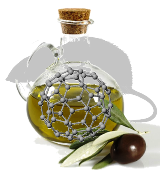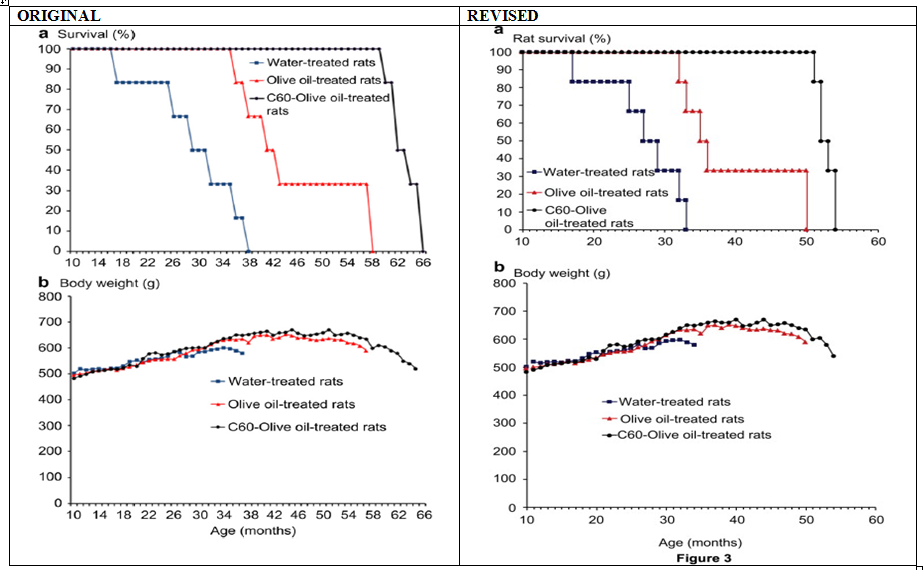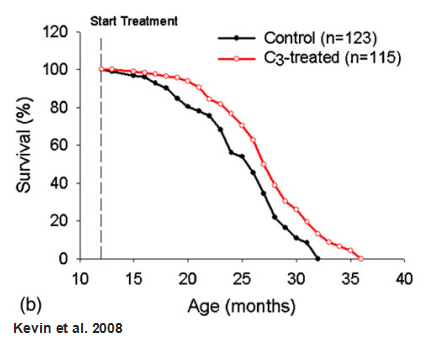Online friends
None of your friends are currently online
Search Articles
Tag Cloud
- depression
- intro
- anxiety
- piracetam
- supplements
- nootropic
- aging
- longevity
- Hello
- noopept
- Dopamine
- modafinil
- brain
- c60
- cancer
- ADHD
- resveratrol
- stack
- 07-04-2015
- health
- choline
- 01-04-2015
- memory
- new
- Aniracetam
- nad+
- nmn
- sleep
- introduction
- diet
- Exercise
- brain fog
- mitochondria
- ----
- rapamycin
- anhedonia
- life extension
- pramiracetam
- oxiracetam
- phenibut
- serotonin
- Supplement
- GABA
- stem cells
- cryonics
- research
- brain health
- ssri
- alcar
- nootropics
Fight Aging News
-
Reduced Glymphatic Flow of Cerebrospinal Fluid Correlates with Risk of Cognitive Impairment
About a decade ago, researchers developed a way t...
Yesterday, 06:19 PM Read Full Story -
A Senescence-Related Target for Blood Vessel Formation
In Aging Cell, researchers have linked macrophage...
Yesterday, 04:00 PM Read Full Story -
Lipid Peroxidation as a Contribution to Sarcopenia
Aged tissues are characterized by increased level...
Yesterday, 10:22 AM Read Full Story -
A Nucleoporin is Involved in Regulating the Beneficial Response to Calorie Restriction
Researchers here find that one of the protein com...
Yesterday, 10:16 AM Read Full Story -
Fight Aging! Newsletter, April 21st 2025
Fight Aging! publishes news and commentary releva...
Apr 20 2025 10:11 AM Read Full Story -
A Physical Activity Study in Obese Individuals Suggests the Burden of Senescent Cells is to Some Degree Dynamic
To what degree is the burden of senescent cells i...
Apr 18 2025 05:47 PM Read Full Story
Carbon nanospheres almost double rat lifespan: a critique
Jul 14 2012 10:19 PM |
ImmInst
in Articles
 by AgeVivo and Sven Bulterijs
by AgeVivo and Sven Bulterijs
more discussion of the paper in question in this thread in the C60 Health sub-forum
this article is a work in progress, it may change over time based on discussions and new information /
Introduction
In June of 2012 an article was published by French and Tunisian scientists showing that C60 dissolved in olive oil significantly extended lifespan in rats (Baati et al., 2012). The Kaplan-Meier survival curve showed almost a doubling of lifespan. C60 is the most well-known family member of the buckminsterfullerenes (so named by their Nobel-prize winning inventors after futurist Buckminster Fuller) made of carbon atoms.
Errors in the initial publication
After publication, in a great example of the effectiveness of public peer review, errors were piced up by members of the public. The authors decided to submit a correction (Baati et al., 2012b); The editor states: “The authors have provided explanations of how the errors were made during the preparation of graphics and images”.
One error was that two controls images (GAog and GAip) were the same image. This error does not affect the global conclusions. The authors explained that they put these figures in at the last moment and made a mistake.
However, the other reported error is impressive: It remains perplexing how the astonishing claim in the most important figure for biogerontologists (the Kaplan-Meier curve) in the paper escaped the notice of the authors, the editor and the peer reviewers: instead of 66 months reported as maximum lifespan for C60 treated rats in the original paper (Baati et al., 2012a), after the correction this is reduced to 54 months (Baati et al., 2012b)
The authors explained that this was caused by using a software program they were not familiar with, making survival lines diagonal instead of vertical. It could be argued that the correction was reflected in he original text. For example, the authors wrote that “the estimated median lifespan (EML) for the C60-treated rats was 42 months”: this is counted starting at age 10 months (beginning of experiment) which leads to 10+42=52 and is indeed aligned with the corrected graph but not the initially published version. Moreover it is straightforward to convert the uncorrected graph into the corrected graph, simply by decaying the x-axis at each diagonal line, to make it vertical.

However, the text describing the survival actually contained (and contains) partial descriptions of the uncorrected graph:
- the paper indicates the age “M38” at which there is 67% survival in the olive-oil-treated group - presumably, this would be “M33” or “M34” based on the corrected graph.
- the EML of the water-treated group was reported to be 22
To some, such confusions around the survival graph casts doubt over the scientific diligence of the author and the editor. Others have argued that the authors have a credible track record but lack experience in lifespan experiments
Strong life extensions reported
Even taking into account the correction, the authors still claim a dramatic effect on lifespan.
Water
The lifepan of the water-treated controls is standard compared to reported Wistar rat lifespans in the literature, if slightly long-lived already (Weindruch and Walford, 1988).
Olive oil
The mean lifespan of the olive oil and the water fed animals was quite similar but the maximal lifespan was increased by an astonishing 17 months. Many health interventions such as healthy diets and exercise have shown to extend the mean but not the maximal lifespan (Skalicky and Viidik, 1999) indicating that they promote health but do not change the rate of aging (de Magalhaes, 2006).
Olive oil has been repeatedly reported to have various health benefits (Bendinelli et al., 2011; López-Miranda et al., 2010; Owen et al., 2004; Perez-Jimenez et al., 2005). Although not all studies go in that direction. Some studies find some health benefits but no lifespan effect (Jacomelli et al. 2010).
Compared to other oils, one study reports the olive oil treatment reduced lifespan in stroke-prone spontaneously hypertensive rats (Ratnayake et al., 2000). Another study in Wistar rats found no difference in mean or maximal lifespan between olive oil and sunflower oil treated rats (Quiles et al., 2004).
What makes the lifespan claims for the olive oil treated rats stand out is that their maximal lifespan is larger than the values reported even for specific life extension studies. For example Weindruch and Walford (1988) report a table with caloric restriction experiments in rats (pg 50-52) where the lifespans for the ad lib. fed Wistar rats varies from 22 to 39 months of age and for the restricted ones from 19 to 46 months of age. Calorie restricted Wistar rats genetically engineered to express an antisense growth hormone construct had a maximum lifespan of 47 months and mean lifespan of 36 months (Shimokawa et al., 2003).
If one believes the figures and rules out a yet-unreported dramatic health effect of olive oil, one might speculate that at some stage during the experiment olive oil may have been contaminated by C60.
C60
The C60 survival is even more striking, with the few rats rats surviving past the age 50 months.
The survival graph indicates that the C60 rats all died between ages 51 and 54 months, which may surprise by its collective suddenness. The corresponding author stated in personal communication that the last two rats were euthanized while not being in very good shape, in accordance with local animal husbandry rules; therefore they may have lived longer, but this had not been documented in the paper. Still, having 4 of the 6 animals dying at such similar times (with a similar pattern for the olive-oil group) is somewhat surprising.
It was questioned whether the C60 group might have been accidentally restricted. It is well know that many compounds, especially when given mixed into the food, can reduce the appetite of the animals (Spindler, 2012). However, in this study the C60 was not mixed into the food and the body weight figures show no evidence of caloric restriction (on the contrary). It should however be noted weight is not always a good marker to estimate caloric intake (Spindler, 2012).
Statistics
It should be stressed that the number of rats in each group was only 6. It is disputed whether this number is or is not too small to draw any meaningful conclusion. Discussion on this point here .
Elements in support of the life extension result
As referenced in the article, there are some indications that fullerenes may have various health benefits, including:
- it has no acute or sub-acute toxicity in rodents (refs 5 to 15 in the paper). Of note, various reports of toxicity of fullerenes exist when dissolved in specific solvants (for a review, see Kolosnjaj, 2007)
- it can act as an antioxidant and is able to scavenge a large number of radicals per molecule (refs 3-6, 21, 44, 47-50 in the paper)

- it can act as a decomposition catalyst for O2.-/H2O2 (ref 4 in the paper)
- it can act as a cytochrome P450 inhibitor (in particular P450 2E1; ref 21 in the paper). In the paper, the authors note some prevention of depletion of reduced glutathione and induce from it that the free-radical scavenging effect is a better explanation.
- it can inactivate Kupffer cells (liver resident macrophages; ref 21 in the paper)
- it has hepatoprotective effects (ref 21 in the paper tests CCl4 toxicity)
Fullerene derivatives were reported to increase the culture density of a green algae (Pseudokirchneriella subcapitata) by 72%, to increase the lifespan of a crustacean (Ceriodaphnia dubia) by about 40%, and to have other positive effects on a plant and a fungus (Gao, 2011). Of course this evidence is at best circumstantial in support of a lifespan effect in mammals.
As a particular comparator study, a carboxyfullerene SOD mimetic extended the lifespan of non-short-lived mice by about 11% and rescued age-related cognitive impairment (Kevin, 2008), right. This much larger study is tentative evidence that buckminster fullerens may have some lifespan benefit.
Of note, Baati et al. (2012) has investigated C60 whereas the cited studies here above have used chemically modified versions of C60 that are expected to behave differently in vivo.
Conclusion
At LongeCity, we are particulary interested in maximum lifespan extension. This paper reported extraordinary findings in this regard and had to retract them to some degree. In a field rife with hype and 'snake oil', scientists, however reputable and objective, have to be extra careful about producing and reporting results. There are some indications that fullerenes may have various health benefits, so it may be premature to dismiss this paper. The study requires repetition in an independent laboratory. This case has illustrated the importance of open and transparent science for progress in life extension research.
References:
» Baati T et al (2012a). The prolongation of the lifespan of rats by repeated oral administration of [60] fullerene. Biomaterials 33(19): 4936-4946.
» Baati T et al (2012b). Corrigendum to “The prolongation of the lifespan of rats by repeated oral administration of [60] fullerene”. Biomaterials 33(26): 6292-6294.
» Bendinelli B et al (2011). Fruit, vegetables, and olive oil and risk of coronary heart disease in Italian women: the EPICOR Study. Am J Clin Nutr 93(2): 275-283.
» Gao J, Wang Y, Folta KM, Krishna V, Bai W, Indeglia P, Georgieva A, Nakamura H, Koopman B, Moudgil B. PLoS One. 2011;6(5):e19976
» Jacomelli M, Pitozzi V, Zaid M, Larrosa M, Tonini G, Martini A, Urbani S, Taticchi A, Servili M, Dolara P, Giovannelli L.
» Dietary extra-virgin olive oil rich in phenolic antioxidants and the aging process: long-term effects in the rat. J Nutr Biochem. 2010 Apr;21(4):290-6. Epub 2009 Apr 14.
» Kolosnjaj J, Szwarc H, Moussa F. Toxicity studies of fullerenes and derivatives. Adv Exp Med Biol. 2007;620:168-80.
» Lin F et al (2010). C20, the smallest fullerene. In: Sattler KD (ed.). Handbook of Nanophysics: Clusters and Fullerenes. CRC Press, Boca Raton.
» López-Miranda J et al (2010). Olive oil and health: summary of the II international conference onolive oil and health consensus report, Jaén and Córdoba (Spain) 2008. Nutr Metab Cardiovasc Dis 20(4): 284-294.
» de Magalhaes JP (2006). Species selection in comparative studies of aging and antiaging research. In: Conn PM (ed.). Handbook of Models for Human Aging. Elsevier Academic Press, Burlington, MA.
» Owen RW et al (2004). Olives and olive oil in cancer prevention. Eur J Cancer Prev 13(4): 319-326.
» Perez-Jimenez F et al (2005). International conference on the healthy effect of virgin olive oil. Eur J Clin Invest 35(7): 421-424.
» Kevin L. Quick, Sameh S. Ali, Robert Arch, Chengjie Xiong, David Wozniak, Laura L. Dugan. A carboxyfullerene SOD mimetic improves cognition and extends the lifespan of mice. Neurobiology of Aging 29 (2008) 117–128.
» Quiles JL et al (2004). Dietary fat type (virgin olive vs. sunflower oils) affects age-related changes in DNA double-strand-breaks, antioxidant capacity and blood lipids in rats. Exp Gerontol 39(8): 1189-1198.
» Ratnayake WMN et al (2000). Vegetable Oils High in Phytosterols Make Erythrocytes Less Deformable and Shorten the Life Span of Stroke-Prone Spontaneously Hypertensive Rats. J Nutr 130(5): 1166-1178.
» Shimokawa I et al (2003). Lifespan extension by reduction of the growth hormone-insulin-like growth factor-1 axis: relation to caloric restriction. FASEB J 17(9): 1108-1109.
» Skalicky M and Viidik A (1999). Comparison between continuous and intermittent physical exercise on aging rats: changes in patterns of spontaneous activity and connective tissue stability. Aging (Milano) 11(4): 227-234.
» Spindler SR (2012). Review of the literature and suggestions for the design of rodent survival studies for the identification of compounds that increase health and life span. Age (Dordr) 34(1): 111-120.
» Tang AC and Huang FQ (1995). Electronic structures of giant fullerenes with Ih symmtry. Physical Review B (Condensed Matter) 51(19): 13830-13832.
» van der Rijst MP et al (1955). Experiments to determine the nutritive value of the average diet consumed in the Netherlands, when fed to white rats ad libitum and under conditions of restricted consumption (70%). Voeding 16: 708.
» Weindruch R, and Walford RL (1988). The retardation of aging and disease by dietary restriction. Charles C. Thomas, Springfield.
more discussion of the paper in question in this thread in the C60 Health sub-forum









































0 Comments